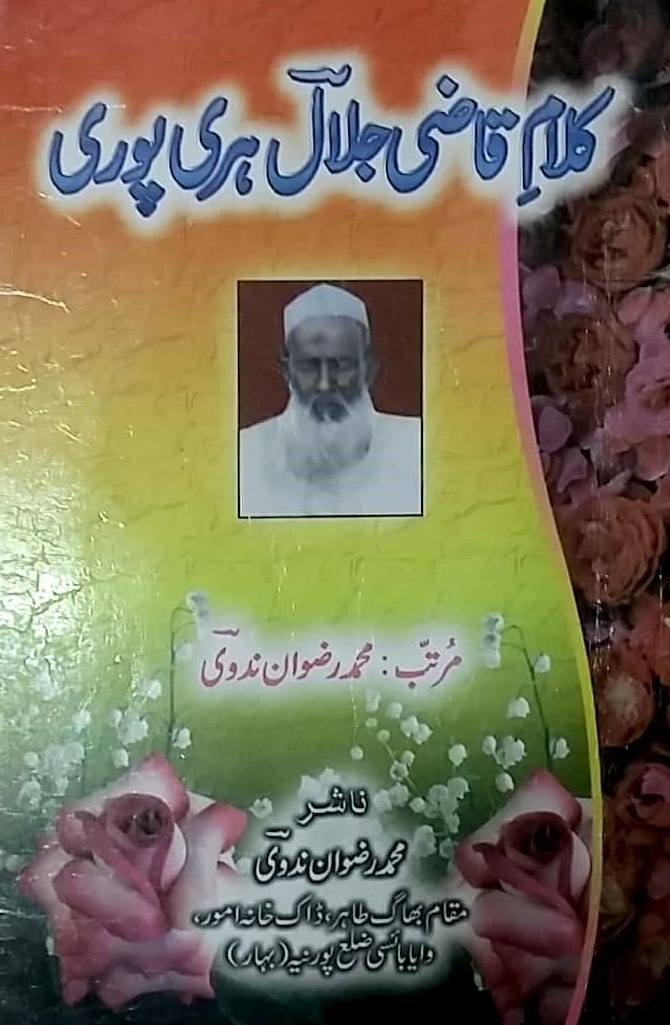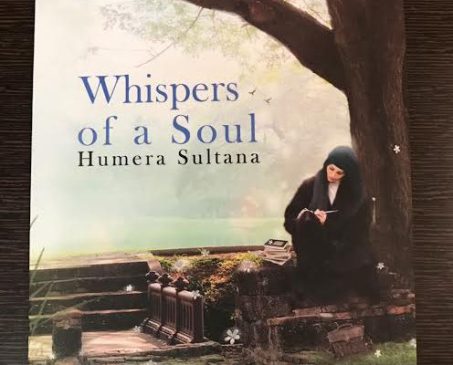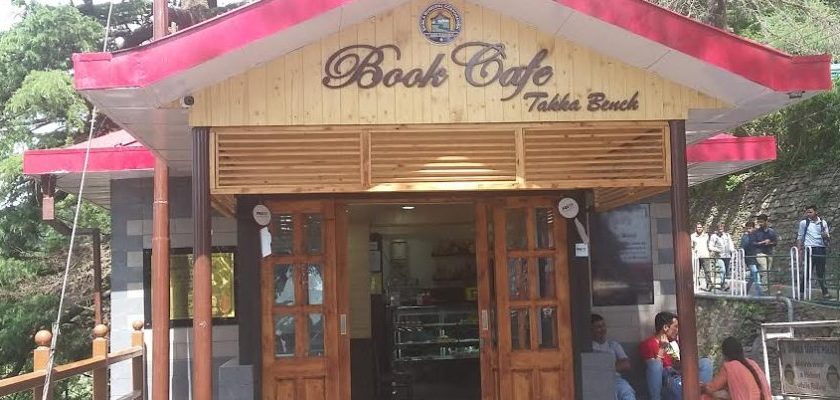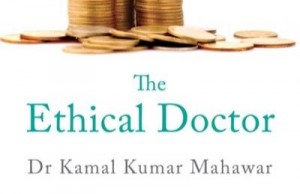Reviewed by ASIF ANWAR ALIG
Kalam-e-Quazi Jalal Haripuri, compiled by Mohd. Rizwan Nadvi, Self-published, Bhaghtahir, PO-Amour, Via-Baisi, Purnea (Bihar)-854 315, 160pp, Indian Rupees 100, Soft.
It doesn’t matter how bigger metamorphosis is witnessed through digital renaissance nowadays. We are equally losing the traditional passion for poetic sanctity. Urdu is thus trapped to ‘became popular under the technical resurgence’ but loses original ascent after such hijacks. An undaunted popularity of that kind shrunk the original Urdu spirit. Select few names as poets are remembered or popularized. Many unsung heroes who endorsed multiple forms of Urdu poetry far from the madding crowds in the rustic environments under limited resources are indeed forgotten faster.
This collection of poems by late Quazi Jalal Haripuri from a remote Haripur village in the Seemanchal region of Bihar entitled Kalam-e-Quazi Jalal Haripuri widens the arena for Urdu poetry lovers. Compiled by his grandson Mohd. Rizwan Nadvi, it preserves a gem of Urdu poetry in the history for the future generations. Self-published yet financially supported by Fakhruddin Ali Ahmad Memorial Committee, Lucknow, this book merits to reach up to wider audiences to introspect that several of the excellent poets are vanishing due to apathies.
Simple yet satiric, pleading to the creature of mankind—Allah and yet romantically vociferous, the poems in Urdu and Persian in the sonnet, couplet, epic and free verses forms peruse readers to feel the presence of the scholastic ideals of a poet who narrated rustic lifestyle in his poetic collage.
Late Quazi Jalal Haripuri was born in 1921 in the economically deprived region’s Bhaghtahir village in Amour under the undivided Purnea District of Bihar. That was a period while British ruled India and Purnea remained center of regional governance. Its inhabitants unfortunately suffered extreme poverty conditions. They hardly had any avenues for quality education then.
While Quazi Jalal Haripuri died on October 28, 1997—after witnessing five decades of India’s freedom from the British—nothing more had changed from what he faced during the colonial rule. His area still lacks in communication infrastructure and lags behind in proportionate growth as compared to India’s national development.
Due to unavailability of resources, late Quazi Jalal Haripuri couldn’t get formal education. He could study in local makatibs (unorganized religious schools) to nearby madarsa (religious school) only. A born poet, his poetic skills were recognized by his poet uncle late Qazi Najmuddin—other finest Urdu and Persian poet. He groomed latter in poetry but only in the initial stages.
Just 17 years of age, young Quazi Jalal Haripuri disseminated poetic maturity through bringing irrefutable sensation. First two lines by him still hypnotizes the poetry lovers by making them think on the poetic sensitivity of a young boy in whom one found the emboldened poetic sensitivity of English romantic poets John Keats (31 October 1795 – 23 February 1821) and William Wordsworth ((7 April 1770 – 23 April 1850). The couplet augurs to think on such perspective:
Hein Mere Nash’ad Dil Mein Seinkr’oun Armaan Bhare
Dil Ko Apne Dil Kahoun Yaa Shouq Ki Duniya Kahoun
[My unhappy heart has many aspirations. Should I consider it my heart or the world of desires?]
Even though there were lack of resources for educational uplift in Purnea centuries before British arrived India, this region still had treasure of poets. They didn’t find opportunity to emerge into national foray but their contributions in Urdu and Persian poetry remain undisputable even today. They deserve to be researched and acknowledged for being region’s poetic gems. Some work has been done in this regard but more research is required to preserve such towering literary works.
Prominent literary figure from Purnea, Professor Tarique Jameeli sheds light on the literary history of this area that Persian and Urdu being the court languages of regional kingdoms gained ample popularity here. It resultantly became hub of poetic discourse although region’s poets couldn’t become popular nationally. He writes about the thematic varieties in late Quazi Jalal Haripuri’s poetry. They have fascination about the region, innocent confessions before the creature of the mankind—Allah, and so do they reflect the happenings nearby the poet as deeper feelings on the social transformations.
Urdu critics Dr. Mulkzada Manzoor Ahmed and Haqqani Al-Qasmi write about the diversified poetic abilities of late Quazi Jalal Haripuri that his poems are extreme reactions to the social anarchies. His Urdu as well as Persian poems spoke up the social dogmas, they opine. Though he composed poetry on various themes, his desperation is seen from the poetic reaction post Babri Masjid demolition:
Kahin Beta’ab Tha Muslim, Kahin Hindu Paresha’n Tha
Haraas wa Khouf Kaa Har Simt Barpaa’ Ek Toofaan Tha
[Somewhere Muslims were impatient and somewhere Hindus in distress. Everywhere there was a tempest of loss, distressfulness and fear.]
This collection of poems by late Quazi Jalal Haripuri is a seminal work for which compiler Mohd. Rizwan Nadvi deserves many accolades. From praises to the Prophet Muhammad (Peace be Upon Him) to defining the beauties of nature in poetic form, it also carries unique elegiac assimilation of a poet with thousands of dreams. His poems espouse social metaphors in praise to the creator of the mankind—Allah and to seek forgiveness in lyrical tone. He also criticized the changing trends in human societies.
Bigartaa Hi Chalaa Jaataa Hai Saaraa Naz’m Aalam Kaa
Saleeqaa Ab Koi Achcha Nahin Hai Ibn-e-Aadaam Kaa!
[The system of the whole world has been turning worse. None of the etiquettes of Adam’s sons are worthy anymore].
His select poems are satires on the human societies. They define the regional traditions on religious festivals, Urdu language, innumerable praise to the beauty of women to poet’s journey to the nearby big city of Katihar where he saw a beautiful girl as if she was nature’s bounty. Besides social satire to proliferating his own feelings or observance, poems by late Quazi Jalal Haripuri suits to all ages.
This compilation is a big contribution in an attempt to preserve the leaflets of history. It brings the works of one of the laurels of Urdu and Persian poetry from Purnea which otherwise couldn’t be traced.
[Asif Anwar Alig is Media Specialist at Prince Mohammad Bin Fahd University, Al-Khobar and assistant professor in the Saudi Ministry of Education. He co-authored a book entitled An Introduction to E-Learning recently.]




